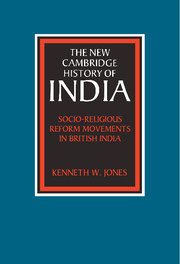Book contents
- Frontmatter
- 1 Concepts and context
- 2 Bengal and north-eastern India
- 3 The Gangetic core: Uttar Pradesh and Bihar
- 4 Punjab and the north-west
- 5 The central belt and Maharashtra
- 6 The Dravidian South
- 7 The twentieth century: socio-religious movements in a politicized world
- 8 Conclusion: religion in history
- Glossary of Indian terms
- Bibliographical essay
- Index
- THE NEW CAMBRIDGE HISTORY OF INDIA
- References
4 - Punjab and the north-west
Published online by Cambridge University Press: 28 March 2008
- Frontmatter
- 1 Concepts and context
- 2 Bengal and north-eastern India
- 3 The Gangetic core: Uttar Pradesh and Bihar
- 4 Punjab and the north-west
- 5 The central belt and Maharashtra
- 6 The Dravidian South
- 7 The twentieth century: socio-religious movements in a politicized world
- 8 Conclusion: religion in history
- Glossary of Indian terms
- Bibliographical essay
- Index
- THE NEW CAMBRIDGE HISTORY OF INDIA
- References
Summary
THE SETTING
The Punjab encompasses the land west of the Sutlej to the Indus River, and from the Himalayan foothills south to the confluence of the Panjnad and Indus Rivers. North of the Punjab are the foothills and the Himalayan mountains that include the Kashmir valley. To the West lies the edge of the Iranian plateau with its sharp hills, tribal groups, and key passes. To the South of eastern Punjab is Rajasthan with its dry, hilly topography that merges to the East with the great Indian desert. Beyond Rajasthan, at the lower end of the Indus River, is Sind, a semi-desert land at the edge of South Asia.
The Hindu-Buddhist cultures of the North-West extend back in time to the third millennium BC and were the first to be incorporated into the Islamic world, Sind in AD 712, and the Punjab by the end of the twelfth century. Majorities of Muslims lived in Sind, western Punjab, and Kashmir. Hindus remained the majority in eastern Punjab, Rajasthan, and the Punjab hills. The religious structure of this region was given a new dimension when Guru Nanak founded Sikhism (see p. 13). In 1799, under the leadership of Ranjit Singh, they established a Sikh kingdom that ruled Punjab and Kashmir.
In 1803 British victories brought them to Delhi and the eastern border of the Sikh kingdom, as the lands between the Sutlej and Jumna Rivers came under British control. After 1818 the princes of Rajasthan accepted British supremacy, and in 1843 Sind was annexed to the Bombay Presidency. The two Anglo-Sikh wars led to the acquisition of the Jullundur Doab in 1846, and of the entire Sikh kingdom in 1849. The British Empire expanded to its geographic limits with a fluctuating border in the trans-Indus territory. This vast surge of the British political sphere, the last such expansion in South Asia, was followed by a much slower uneven growth of the cultural milieu.
- Type
- Chapter
- Information
- Socio-Religious Reform Movements in British India , pp. 85 - 121Publisher: Cambridge University PressPrint publication year: 1990



